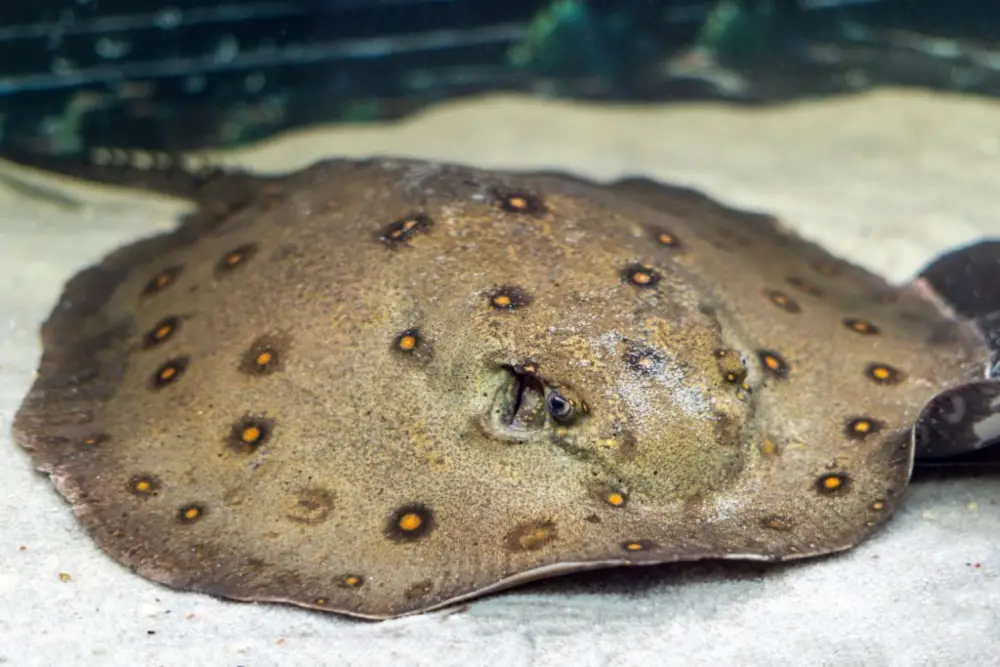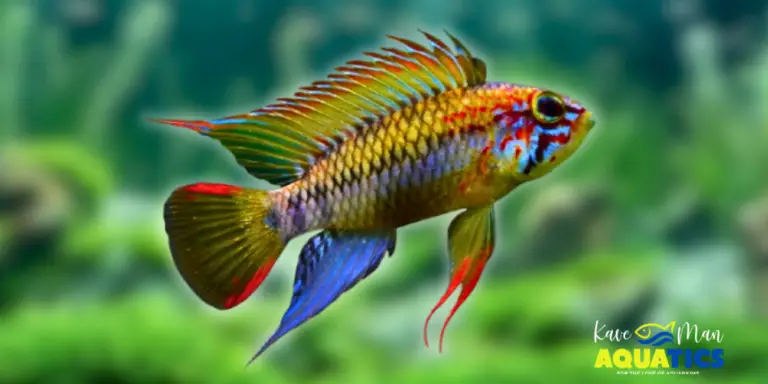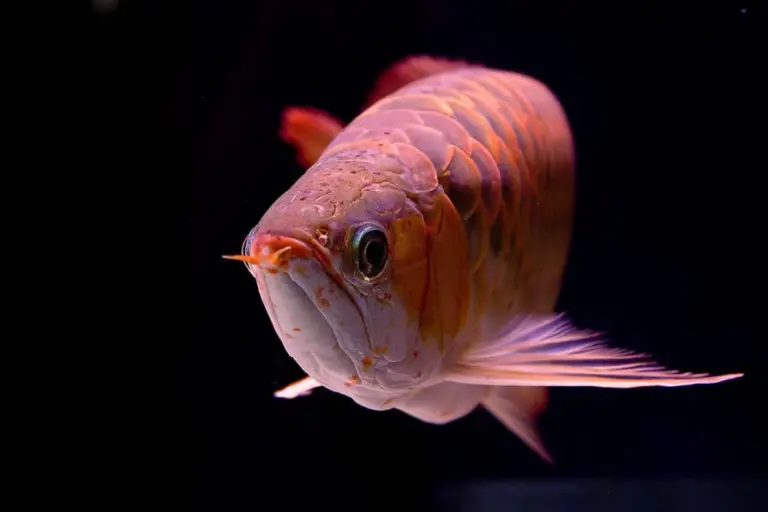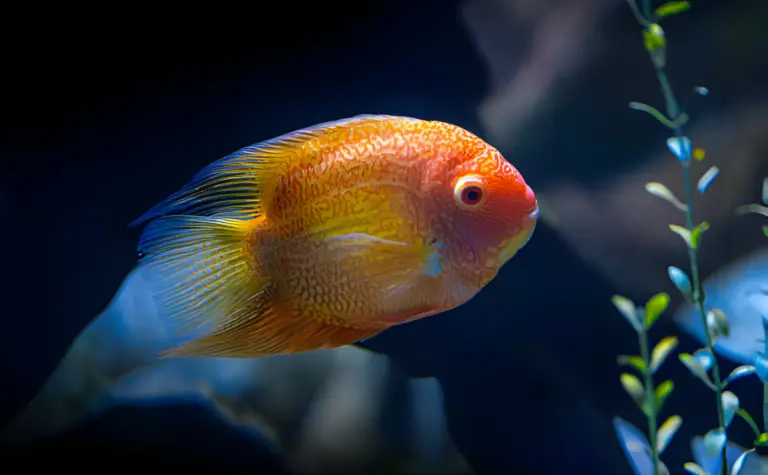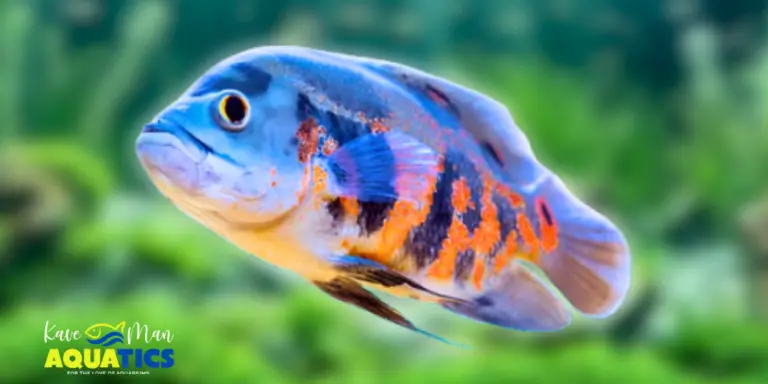Freshwater Stingray — A Complete Species Profile and Care Guide
Ready to own your first freshwater stingray but don’t know where to begin? We’ve got you covered. These graceful aquatic creatures are like no other, and we’re here to take you on an exciting journey to discover all there is to know about them.
In this comprehensive species profile and care guide, we’ll unlock the secrets of the mysterious freshwater stingray. From their elegant disc-shaped bodies to their intriguing behaviors, we’ll delve into every aspect of their unique existence. Whether you’re a curious beginner or an experienced hobbyist, you’re in for a treat!
Freshwater Stingray Overview
| Family | Potamotrygonidae |
| Species | P. motoro (Motoro Stingray), P. leopoldi (Leopoldi Stingray), P. orbignyi (Ocellate River Stingray), P. henlei (White-blotched River Stingray), P. falkneri (Falkner’s River Stingray) |
| Common Names | Freshwater stingray, River stingray |
| Location | South America |
| Size | 8 – 18 inches (20 – 45 centimeters) in diameter, depending on the species |
| Life Expectancy | 5 – 10 years average — in captivity |
| Appearance | Flat disc-like body, broad pectoral fins, long and slender tail |
| Color | Brown, black, gray, white or pale and even blue, green and yellow with a variety of patterns and markings |
| Diet | Carnivores — small fish, crustaceans, insects, mollusks |
| Behavior | Shy, timid, skittish — depending on the species, individual temperament, and environment |
| Tank Size | 180 gallons (around 681 liters) per adult stingray |
| Temperature | 77°F – 82°F (25°C – 28°C) |
| pH | 6.5 – 7.5 |
| Water Type | Freshwater |
| Hardness | Soft, 2 – 10 GH (35 – 175 ppm (parts per million) of total dissolved solids (TDS)) |
| Care Level | Difficult — requires a significant level of expertise, experience, and dedication |
| Breeding | Ovoviviparous breeders — give birth to live offspring |
About the Freshwater Stingray
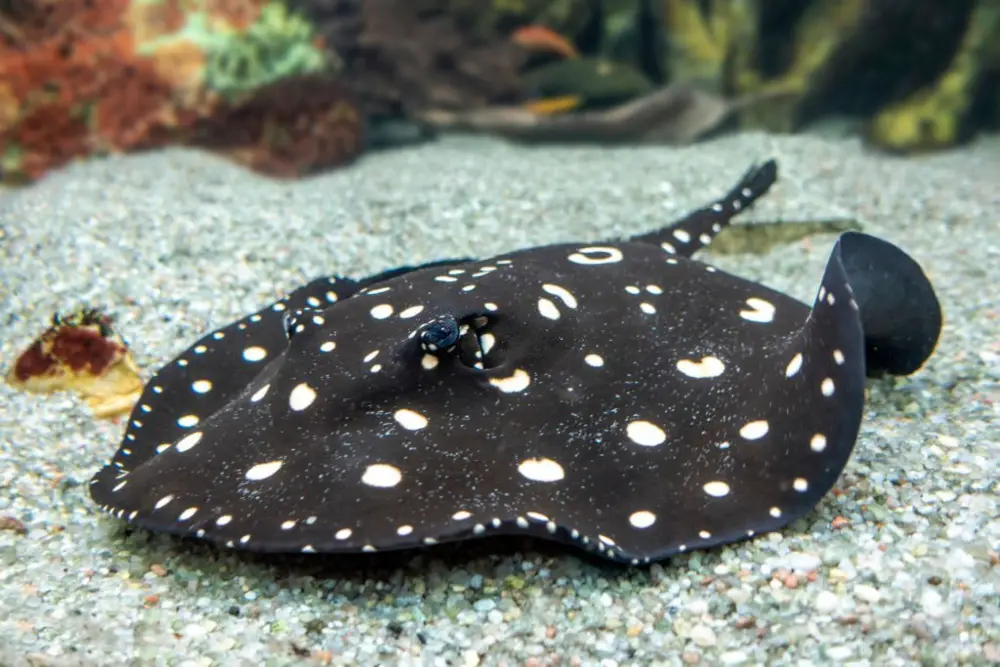
These graceful creatures, also known as Potamotrygonidae, are an intriguing addition to any fish-keeping adventure. With their flat, disc-like bodies and elegant movements, freshwater stingrays are a sight to behold. Let’s dive into the intricacies of these beauties.
Distribution and Habitat
These captivating creatures can be found gliding through the waters of the Amazon and Orinoco basins in South America. From the lush riverbeds of Brazil to the winding waterways of Venezuela, these regions serve as the natural playground for these remarkable stingrays.
Freshwater stingrays are masters of adaptation, preferring slow-moving or stagnant waters with sandy or muddy substrates. Their flat, disc-like bodies and exceptional camouflaging abilities make them blend seamlessly with their surroundings, making them skilled ambush predators.
In their native habitats, these stingrays often seek refuge under sand or riverbed debris during the day, emerging under the cloak of night to explore and hunt for their favorite meals.
When setting up their home away from home, aim to replicate the soft, sandy substrate and provide plenty of hiding spots to mimic the riverbeds they know so well. A well-designed aquarium that emulates their native habitat will not only make them feel at ease but also reveal their natural behaviors and gracefulness.
Appearance and Colors
These graceful creatures boast a truly unique appearance that sets them apart from any other fish in the aquarium world.
Freshwater stingrays have a disc-like body shape, resembling a large pancake or a rounded triangle. This flattened body allows them to glide effortlessly through the water, showcasing their elegance with every movement. Their pectoral fins, often referred to as “wings,” extend outward from the sides of their body, giving them an appearance akin to a majestic underwater bird in flight.
When it comes to colors and patterns, freshwater stingrays don’t disappoint! While individual species may display slight variations, many of them exhibit captivating hues of brown, black, gray, and white on their dorsal (upper) side. These colors help them expertly blend in with the sandy or muddy riverbeds, providing them with the perfect camouflage to surprise their prey.
Some species may even have spots, dots, or intricate patterns scattered across their bodies, making them truly eye-catching additions to your aquarium.
Behavior
These enigmatic creatures have developed unique habits and instincts that make them a fascinating addition to any aquarium.
Freshwater stingrays are primarily nocturnal, meaning they are most active during nighttime. During the day, you might find them seeking refuge under the sand or riverbed debris, perfecting their art of stealth and camouflage.
Despite their graceful appearance, stingrays are known for being shy and skittish. Sudden movements or disturbances can startle them, prompting them to seek cover and hide from perceived threats.
They are bottom-dwellers, spending much of their time gliding gracefully along the riverbed. Some species may even partially bury themselves in the soft substrate, using their disc-like bodies to blend in seamlessly with their environment.
Tank Requirements

Please ensure that before adding any new fish to a tank, it’s properly cycled. That’s where a quarantine tank can be very valuable.
| Tank Size | 180 gallons (around 681 liters) per adult stingray |
| Temperature | 77°F – 82°F (25°C – 28°C) |
| pH | 6.5 – 7.5 |
| Water Type | Freshwater |
| Hardness | Soft, 2 – 10 GH (35 – 175 ppm (parts per million) of total dissolved solids (TDS)) |
| Substrate | Soft fine-grained substrate (sand or sand and silt) — as they are bottom dwellers |
| Filter | Yes, a power filtration system capable of handling the bio-load is required. Stingrays are sensitive to water quality, and maintaining clean and stable water conditions is essential for their well-being |
| Plants | Yes, it’s generally okay to add live plants to a freshwater stingray tank — Anubias, Java Fern, Amazon Sword, and Java Moss |
Tank Size
When it comes to creating a cozy home for your freshwater stingrays, size matters! These graceful beings need ample space to glide and explore, making the right tank size a top priority.
For young stingrays, start with a tank size of at least 75 gallons (around 284 liters) to provide them with enough room to grow and develop. However, as these majestic creatures mature, they’ll need even more space to spread their “wings.”
For adult freshwater stingrays, a minimum tank size of 180 gallons (around 681 liters) is recommended. A tank with adequate floor size and height will allow them to move freely without feeling cramped.
Remember, stingrays are bottom-dwellers, so providing a tank with more floor space than height is essential. A longer tank allows them to showcase their elegant movements and fully utilize their pectoral fins.
Having enough swimming space not only keeps your stingrays happy but also promotes their natural behaviors and reduces stress. So, think big and give your freshwater stingrays the spacious paradise they deserve!
Filtration
Freshwater stingrays are quite sensitive to water quality, so a robust filtration system is a must-have. Opt for a powerful filtration system, like a canister filter or a sump filter, that can handle the bio-load and maintain excellent water conditions.
Mechanical filtration is your first line of defense, trapping physical debris and waste particles. Next up, biological filtration comes into play, where beneficial bacteria work their magic to convert harmful ammonia and nitrite into less toxic nitrate.
Don’t forget about regular maintenance! Keep an eye on your filter, clean the mechanical media, and replace any worn-out components as needed. A happy and healthy freshwater stingray starts with crystal-clear water, so make sure your filtration game is on point!
Temperature
These magnificent creatures hail from the tropical regions of South America, so they like it warm and toasty. Aim to maintain a water temperature between 77°F to 82°F (25°C to 28°C) to keep your stingrays feeling cozy and content.
Invest in a reliable aquarium heater with a thermostat to regulate the temperature and keep it stable. A stable temperature is crucial for the well-being of your stingrays, as sudden fluctuations can stress them out.
Lighting
Freshwater stingrays have an inclination for nightlife, so they prefer dimly lit environments. Avoid bright, intense lighting that might stress them out. Instead, opt for low-intensity or adjustable LED lights that mimic the natural lighting conditions of their native habitats.
Setting up a lighting schedule is essential to establish a day-night cycle for your stingrays. Aim for around 10 to 12 hours of light during the day, followed by darkness at night.
Adding some floating plants or placing the light source above the aquarium lid can help diffuse and reduce the intensity of the light, creating a more comfortable environment for your aquatic buddies.
pH and Hardness
Freshwater stingrays prefer slightly acidic to neutral pH levels, ideally between 6.5 to 7.5. This pH range mimics the gentle waters of their native Amazon and Orinoco river basins. Use a reliable pH test kit to monitor and adjust the pH as needed, ensuring a stable and comfortable environment for your stingrays.
When it comes to water hardness (GH), keep it on the softer side, around 2 to 10 degrees of GH (35 to 175 ppm). These soft waters resemble the cozy, sandy riverbeds they love exploring.
Maintaining the right pH and hardness levels ensures your freshwater stingrays feel right at home, promoting their health, and revealing their vibrant personalities. With a little water chemistry magic, you’ll have a thriving aquatic paradise to enjoy together!
Substrate

Choosing the right substrate is crucial for your stingrays’ comfort and natural behaviors. Opt for fine sand or a mix of sand and silt to mimic the riverbeds they love to explore in their native habitats. This soft substrate allows your stingrays to partially bury themselves, showcasing their excellent camouflage skills.
Aim for a substrate depth of about 2 to 4 inches (5 to 10 centimeters) to provide enough room for them to bury and glide gracefully.
Remember, rough or sharp substrates can be uncomfortable for your stingrays, so keep it smooth and gentle for their delicate undersides.
Plants
Live plants not only enhance the beauty of your aquarium but also offer several benefits for your stingrays. They provide additional hiding spots, creating cozy nooks for your stingrays to retreat and feel secure. Plus, they help maintain water quality by absorbing excess nutrients and reducing algae growth.
Opt for hardy plant species that can tolerate the water conditions in your tank, such as Anubias, Java Fern, or Amazon Sword. These low-maintenance plants will thrive alongside your stingrays with ease.
However, keep in mind that freshwater stingrays may disturb or uproot plants in their explorations. If this happens, don’t worry! You can try anchoring the plants or using floating varieties to give them a chance to flourish.
Diet and Eating Habits
Freshwater stingrays are carnivorous creatures that have a hearty appetite for meaty delights. In their native habitats, they feast on small fish, crustaceans, and insects. In captivity, you can replicate their diet by providing them with a variety of live or frozen foods.
Offer them high-quality foods such as bloodworms, brine shrimp, krill, and chopped fish. Ensure the food is appropriately sized, as stingrays have small mouths and prefer bite-sized morsels.
Feeding time can be an exciting spectacle as they gracefully glide to snatch their meal. Observe their eating habits and adjust the feeding schedule accordingly. Stingrays are typically more active during the night, so feeding them after the lights are dimmed is a great idea.
Remember, overfeeding can lead to health issues, so moderation is key. As a rule of thumb, feed them as much as they can consume in 2 to 3 minutes, two to three times a day when they are young, and reduce the frequency as they mature.
With a well-balanced and nutritious diet, your freshwater stingrays will showcase their vibrant personalities and stay in top form, becoming the stars of your aquatic show!
Tank Mates
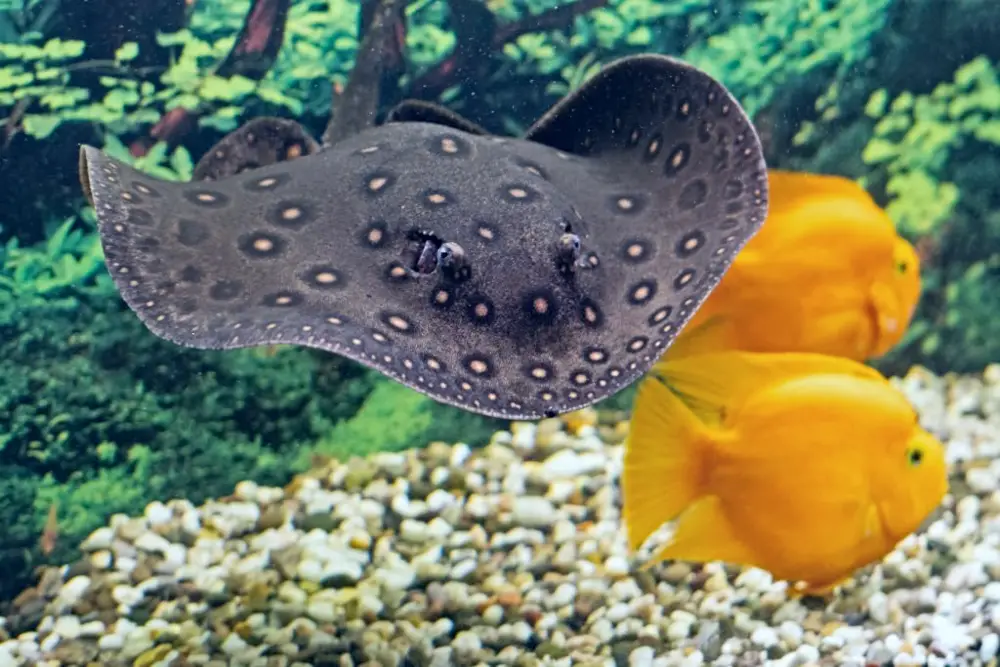
When it comes to tank mates, it’s crucial to choose peaceful and compatible species that won’t stress out our graceful stingrays. As bottom-dwellers, freshwater stingrays prefer to share their space with other peaceful fish occupying different aquarium levels. Avoid aggressive or territorial fish that might hassle your stingrays or disrupt their tranquil environment.
Some suitable tank mates include:
- Tetras: Many species of tetras, such as Cardinal Tetras, Rummy Nose Tetras, and Neon Tetras, are peaceful and have vibrant colors, making them great tank mates for freshwater stingrays.
- Rasboras: Rasboras, like Harlequin Rasboras and Chili Rasboras, are small, peaceful fish that can add activity and color to the aquarium without causing conflicts.
- Corydoras Catfish: Corydoras catfish are bottom-dwellers like stingrays and are known for their gentle nature. They can also help keep the substrate clean by scavenging for food particles.
- Dwarf Cichlids: Some dwarf cichlid species, such as Apistogramma and Mikrogeophagus (German Blue Rams), can be suitable tank mates if they are non-aggressive and occupy different areas of the aquarium.
- Plecos: Certain smaller Pleco species, like the Bristlenose Pleco, can be compatible with freshwater stingrays and help with algae control.
- Silver Dollar Fish: Silver Dollar Fish are peaceful and have a distinct round shape, adding a unique look to the tank.
Remember, the size of the tank matters! With their impressive size and gliding movements, stingrays need ample swimming space. A spacious aquarium will prevent overcrowding and potential territorial issues among the tank mates.
Always keep a close eye on the interactions between your freshwater stingrays and their companions. If any signs of stress or aggression are observed, it’s best to make adjustments to ensure the harmony of your underwater community.
Breeding
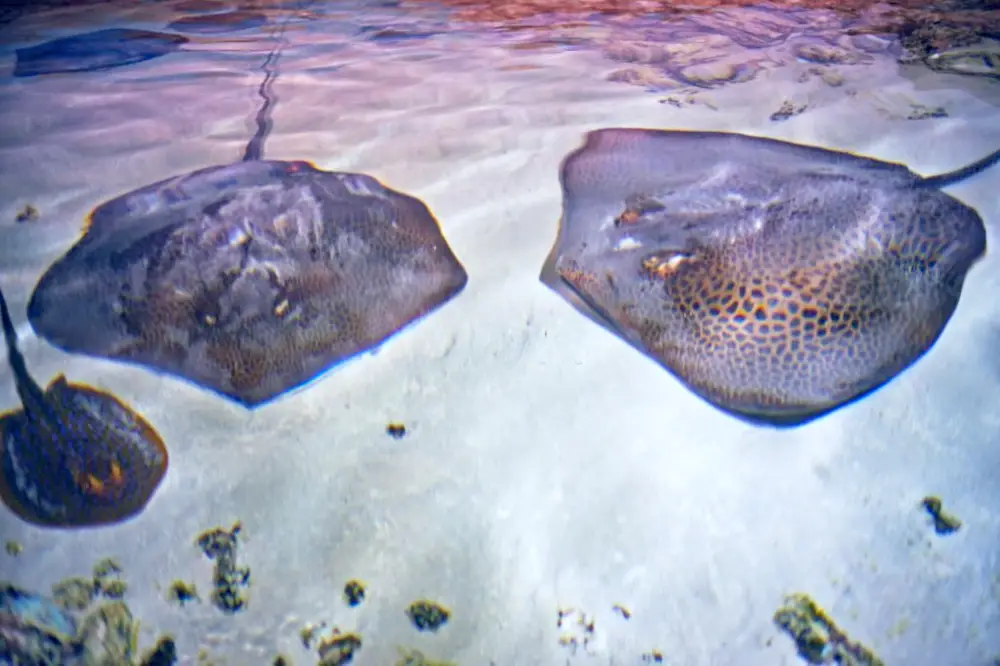
First and foremost, ensure you have a mature and healthy pair of stingrays ready for breeding.
For most freshwater stingray species, females typically reach sexual maturity at around 2 to 3 years of age. At this stage, they are physically and biologically ready to reproduce and give birth to live young. Male freshwater stingrays, on the other hand, may reach sexual maturity a bit earlier, usually between 1.5 to 2 years of age. Once sexually mature, males develop claspers, specialized pelvic fins used during mating.
Typically, females are larger and broader than males. Male freshwater stingrays possess specialized pelvic fins known as claspers, which play a vital role in the mating process. During mating, the male uses these claspers to attach to the female in a ventral-to-ventral position, facilitating fertilization.
Observe their behavior and look for signs of courtship, such as frequent gliding together or rubbing against each other.
Creating the right environment is crucial for successful breeding. Maintain optimal water conditions, including the ideal pH, temperature, and water quality. Adequate hiding spots and dim lighting will make your stingrays feel more at ease during the process.
Unlike many other fish species, freshwater stingrays are ovoviviparous, which means they give birth to live young instead of laying eggs. The developing embryos remain inside the mother’s uterus, where they receive nourishment from a special secretion called histotroph produced by trophonemata glands.
The gestation period for freshwater stingrays can vary, lasting anywhere from 3 to 12 months, depending on the exact species. Each litter can consist of between 1 to 21 pups, making the arrival of baby stingrays an exciting and diverse event.
Interestingly, the breeding cycle of freshwater stingrays is often influenced by flood levels, connecting their reproductive behavior to the natural rhythms of their native habitats.
Breeding freshwater stingrays can be challenging, but it’s a fascinating journey for experienced hobbyists. If you’re a beginner, it’s best to gain more experience in fish-keeping before venturing into the world of stingray breeding. Take your time, do your research, and with patience and dedication, you may be rewarded with a new generation of these magnificent creatures!
Your Stingray Adventure Begins!
Congratulations, aspiring fish-keeping enthusiasts! You’ve now become experts on the captivating world of freshwater stingrays, thanks to our comprehensive species profile and care guide. From their elegant appearances to their unique behaviors, you’ve unlocked the secrets to providing the best care for these mesmerizing aquatic creatures.
But hey, we understand that embarking on this exciting journey might still feel like a new adventure. That’s why we’re here to help! For personalized guidance and 1-on-1 coaching, reach out to KaveMan Aquatics.
Together, let’s create a thriving and harmonious underwater haven that your freshwater stingrays will call home. Happy fish-keeping!
Feel free to enjoy our stingray playlist where KaveMan Aquatics document their journey of owning freshwater stingrays:
-
Freshwater Stingray — A Complete Species Profile and Care Guide
Discover the world of freshwater stingrays! Our care guide and species profile have everything fish-keeping beginners need to create a thriving aquatic haven.

